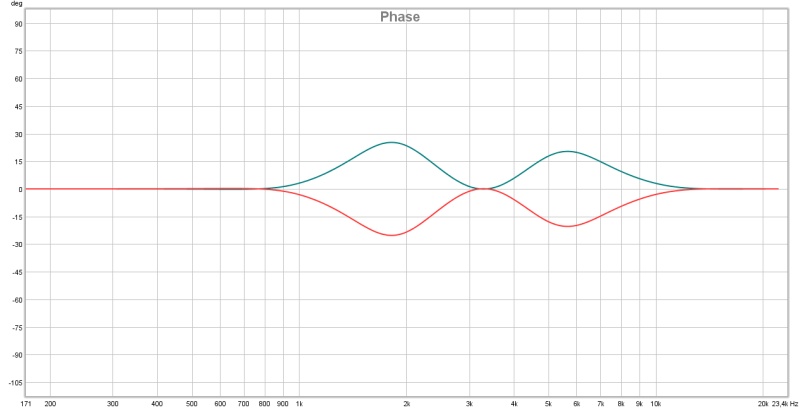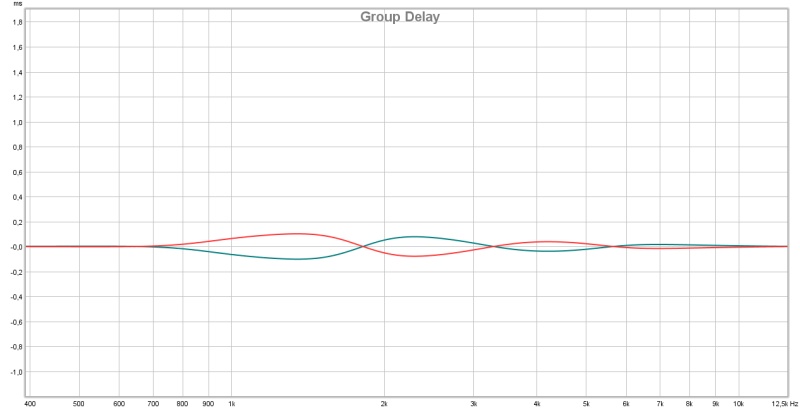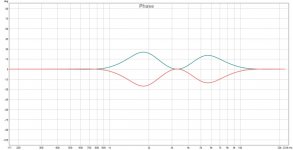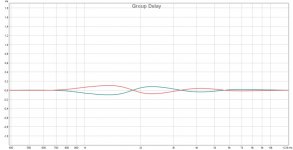A workaround is to pré-convolve some songs, actually look at the post from (dyno)Mike to find a whole bunch of them ready to play. That was the easiest way for me to start testing. I pré-convolved a couple of songs I know well to test. I'll honestly admit I have downloaded Mike's samples but haven't listened to them. Because I included the shuffler in my processing chain a while ago. A simpler one with only two minimal shuffles. Attached it to this post.

Here's Mike's post: http://www.diyaudio.com/forums/multi-way/277519-fixing-stereo-phantom-center-31.html#post4694966
Here's Mike's post: http://www.diyaudio.com/forums/multi-way/277519-fixing-stereo-phantom-center-31.html#post4694966
Attachments
Last edited:
With regard to early reflections, I don't fully understand it, but Linkwitz and I have found from experience with open-baffle speakers, that the reflected rear output of the OB speakers has a positive psycho-acoustic effect if the delay is greater than about 6mS (so OB speakers need to be at least 3 feet out from the front wall and side walls of the listening room), and a negative psycho-acoustic effect if it's less than that. So I'm thinking that it's the early reflections that are less than 6mS that are specifically the ones to try and minimize.
Back to the shuffler.
Like some others I may not understand in full detail what a shuffler does. Apparently it shifts phase at certain frequencies only (?), such that center image cancellations due to our 2 binaural ears, no longer cancel at those frequencies (?). So one channel is shifted by maybe +45 degrees, and the other is shifted by -45 degrees (?). Is the shift static, or does it ever periodically change, so the brain can't lock in on it's presence?
If you wanted to minimize the comb filter effect of L only and R only signals (when using a shuffler), the L-XR matrix working against the L+R function might give one the opportunity of affecting the center images significantly more than the outer L and R only images. You somewhat extract L+R away from everything else, process it with the shuffler, and then mix it back in with L-XR and R-XL, to get back to two channels. This method may have significant crosstalk issues, but may still be an improvement (?).
Back to the shuffler.
Like some others I may not understand in full detail what a shuffler does. Apparently it shifts phase at certain frequencies only (?), such that center image cancellations due to our 2 binaural ears, no longer cancel at those frequencies (?). So one channel is shifted by maybe +45 degrees, and the other is shifted by -45 degrees (?). Is the shift static, or does it ever periodically change, so the brain can't lock in on it's presence?
If you wanted to minimize the comb filter effect of L only and R only signals (when using a shuffler), the L-XR matrix working against the L+R function might give one the opportunity of affecting the center images significantly more than the outer L and R only images. You somewhat extract L+R away from everything else, process it with the shuffler, and then mix it back in with L-XR and R-XL, to get back to two channels. This method may have significant crosstalk issues, but may still be an improvement (?).
The phase is altered like in the picture I just edited in in the post above you (static phase change).
This phase change shifts one ear's comb null up in frequency and the other ear down.
The real time change is minimal:

0,101 ms time change...
The left channel solo does not have a combing problem, nor does the right one (by itself) have it. The combing occurs because of the same material coming from both speakers. Yes, there is still crosstalk (to the right ear) with only a left channel playing. But we are not trying to solve that problem. No combing though. That only happens for the sounds that play simultaneously in both channels. The crosstalk signal of the left speaker (arriving at the right ear ~0.27 ms late) combs with the right direct sound and vice versa.
This shuffler is not fixing or altering anything panned hard left or hard right. No need for a separation of the treatment, unless your hearing picks up on a 0.1 ms timing difference. Calculate the distance of that to figure out how far we have "moved" the sound compared to the original by introducing this phase shuffle. It's minimal, 3.4643 cm according to an online calculator.
This phase change shifts one ear's comb null up in frequency and the other ear down.
The real time change is minimal:
0,101 ms time change...
The left channel solo does not have a combing problem, nor does the right one (by itself) have it. The combing occurs because of the same material coming from both speakers. Yes, there is still crosstalk (to the right ear) with only a left channel playing. But we are not trying to solve that problem. No combing though. That only happens for the sounds that play simultaneously in both channels. The crosstalk signal of the left speaker (arriving at the right ear ~0.27 ms late) combs with the right direct sound and vice versa.
This shuffler is not fixing or altering anything panned hard left or hard right. No need for a separation of the treatment, unless your hearing picks up on a 0.1 ms timing difference. Calculate the distance of that to figure out how far we have "moved" the sound compared to the original by introducing this phase shuffle. It's minimal, 3.4643 cm according to an online calculator.
Attachments
Last edited:
A workaround is to pré-convolve some songs...
Good idea, simplest for me indeed.
With regard to early reflections, I don't fully understand it, but Linkwitz and I have found from experience with open-baffle speakers, that the reflected rear output of the OB speakers has a positive psycho-acoustic effect if the delay is greater than about 6mS (so OB speakers need to be at least 3 feet out from the front wall and side walls of the listening room), and a negative psycho-acoustic effect if it's less than that. So I'm thinking that it's the early reflections that are less than 6mS that are specifically the ones to try and minimize.
Close to back wall , and even corner placement, are not an issue for me when boundary/Allison effects are correctly adressed through eq. Btw, i don't like to stumble with speakers bothering in half the middle of the room.
Moreover speakers seem to sound way better to me when just sticked to boundaries. Might like (equed) VER...😀
Last edited:
I don't think it's better, but it is one of the best plugins I've used.Though the Smyth Realiser mimics a measured true Stereo setup and the above plugin concentrates on adjustable head related stuff, so it might even do a bit better.
 Been running it a year or two now. I've missed a few chances to hear the Smyth, but reports from people I know and trust say it's uncanny. Really want to hear it. I have head the DTS version and it works surprisingly well, for a "one size fits all".
Been running it a year or two now. I've missed a few chances to hear the Smyth, but reports from people I know and trust say it's uncanny. Really want to hear it. I have head the DTS version and it works surprisingly well, for a "one size fits all".The plugin never gets the sound much out past the edge of the headphones (for me) but it does make it less stuck in the head. It has never come close to fooling me into thinking the sound is coming from in front of me. But I like it for what it can do.
It's not that the comb filter effects from the rear emission of the OB speakers mess up the imaging and/or apparent depth (maybe a little, but they're pretty similar side to side). That happens regardless of the distance of the OB spkrs to the walls. It's a psycho-acoustic effect that has influence on the sense of soundstage. Once the speakers are at least 3 feet from any room boundaries (a minimum of about 6mS delay of the rear emission bouncing off walls), they do a pretty good job of disappearing, and the soundstage has apparent depth and even height. When I engage the inter-aural cancellation circuit, the soundstage extends significantly beyond the boundaries of the speakers (if you're at the sweetspot), although it leaves me with the "phasey" sounding center image. Once my 2 > 3 channel "Extractor" circuit is done, I expect to have a solid center image too.Close to back wall , and even corner placement, are not an issue for me when boundary/Allison effects are correctly adressed through eq. Btw, i don't like to stumble with speakers bothering in half the middle of the room.
Moreover speakers seem to sound way better to me when just sticked to boundaries. Might like (equed) VER...😀
I wonder the same thing, but don't know how to measure it. My guess is that even the piles of gravel and debris absorb a fair amount of sound. Many lot of the walls and some of the floor are pahoehoe lava, so not very porous and probably reflect a lot more than they absorb. So it's a mix, a good mix.I wonder how much absorption the lava rock actually does to add to the random reflective nature of your man cave?
Thanks Pano, I was thinking that the lava rock was very porous, I didn't know there was a more solid type so that is something new to learn. Who knows what loose gravel does. I guess you could do a decay test but your tunnel is so long not sure it would have much meaning in the scheme of things.
Once the speakers are at least 3 feet from any room boundaries (a minimum of about 6mS delay of the rear emission bouncing off walls), they do a pretty good job of disappearing, and the soundstage has apparent depth and even height.
Sorry, but the 6ms and similar is no longer fixed law for me, quite the contrary, just an abritrary common wisdom based convention which made me life impossible before, till i decided to get rid of it no long ago, and quite happy to have done so.
Btw, my main concern with dipoles, and the reason why i don't really wish to try with them. Still have Pluto and LX mini on my list though..
Last edited:
@ Wesayso
Thanx for the Smyth Realiser info, which i had a look at. Interestingly, in the blog they actually mention TB_Isone. Though it's not the same, it does seem to share a number of similar functions etc. BIG difference in price though 😀
Thanx for the Smyth Realiser info, which i had a look at. Interestingly, in the blog they actually mention TB_Isone. Though it's not the same, it does seem to share a number of similar functions etc. BIG difference in price though 😀
It certainly is a problem, and one we've discussed before. Lynn Olsen mentions this frequently, usually in the frame of speakers and electronics not being able to to large ensembles and mass voices well. It's not easy, and can certainly lead to disappoint in listening to this type of music.You know, what this points out is the difficulty of designing a speakers for "the market". What market is that? The vast studio work market? or the relatively tiny classical market? I will admit that my speakers, room and setup works exceptionally well for studio work, but I am always disappointed with classical recordings. This could be two things: either the recordings are all bad; my setup does not do classical very well; or there is simply no way to achieve realism of a large venue in a small room.
As it's something I enjoy, I pay attention to it. I've heard reasonable, and even very good, facsimiles of the concert hall, choirs and orchestras in medium sized rooms. Once or twice in small rooms, so I know it is possible, tho very difficult. The speakers were never small, tho. In my lava cave big venue recordings work spectacularly well, but it's a big space, about 70ft long. Even old mono recordings have depth if they were recorded in a big space. Those are not large speakers, but the space is.
That said, I've tried to get big spacial playback on large PA systems in large venues and it's never worked well. Not sure why.
No problem, Zero D,
Now if only we had an unlimited budged to be able to try out all of this interesting stuff and the cute gadgets. 🙂
The last street price for the Choueiri device called BACCH SP I have seen was astronomically high.
It still is interesting though 🙂. And it better be good!
Now if only we had an unlimited budged to be able to try out all of this interesting stuff and the cute gadgets. 🙂
The last street price for the Choueiri device called BACCH SP I have seen was astronomically high.
Read more at: BACCH SP reviewStereophile said:The price (including infrared tracking cameras, microphones, and a dedicated iPad controller) is $54,000. But this is only the start, in a few years our children will be swimming with the Little Mermaid and racing at Monte Carlo.
It still is interesting though 🙂. And it better be good!
As it's something I enjoy, I pay attention to it. I've heard reasonable, and even very good, facsimiles of the concert hall, choirs and orchestras in medium sized rooms. Once or twice in small rooms, so I know it is possible, tho very difficult. The speakers were never small, tho.
The realistic SPL level does not matter for me. SPL only dependent to distance to the source, so irrelevant matter to me, so that size/power is certainly not an issue for me.
Main trouble for me is on the recording side with overengineered multi mike garbage recordings made by studio terrorists that suck, killing the magic of the event owing to excess attention to irrelevant details to the mix!😡
Last edited:
😱 It's in orbit!The last street price for the Choueiri device called BACCH SP I have seen was astronomically high
Makes the Smyth Realizer seem like a legit bargain at around $3K. Considering it could replace a very good hi-fi system and room, it would be worth it. I really need to get some time with one of these.
It's not the SPL that's the problem. I've just never heard small speakers do the illusion at any SPL. One exception is my Troglodyte speakers which are just a 12"+3" on a board. simple passive crossover. But the room is unusual, to say the least.The realistic SPL level does not matter for me. SPL only dependent to distance to the source, so irrelevant matter to me, so that size/power is certainly not an issue for me:
There is much more going on than just SPL.
It's not the SPL that's the problem.
The main problem with big venues is on the recording side, just too obvious.
https://www.youtube.com/watch?v=qW6Mwr7xVxY
It's not the SPL that's the problem. I've just never heard small speakers do the illusion at any SPL. One exception is my Troglodyte speakers which are just a 12"+3" on a board. simple passive crossover. But the room is unusual, to say the least.
There is much more going on than just SPL.
Any chance of you visiting ra7 at any time in the future? I know he has heard your previous setup and he seems to really enjoy his new (corner) toys. He's pressed for time to set it all up properly, yet seems to enjoy what he's got so far. I know there's still room for improvement as he's still working on it.
By the way, we haven't heard back from him trying the one bump shuffler, have we?
He's a busy papa, we have to be patient. 🙂 He visited me in Kona just before I got the cave, wish I had it when he was here. We were supposed to meet in Orlando earlier this year, but both of us were so busy we forgot until we were on our return flights! I'd love to visit his new place and hear those corner line arrays.
Fun video, thanks for the link. I've gotten so used to modern consoles that I kept expecting the faders to move by themselves. 😀The main problem with big venues is on the recording side, just too obvious.
Not sure what the video has to do with problems in big venue recordings, tho.
- Home
- Loudspeakers
- Multi-Way
- Fixing the Stereo Phantom Center

